Key takeaways
- Activist teacher resources empower educators to connect lessons with real-life issues, fostering critical thinking and social awareness in students.
- Flipgrid enhances student engagement by allowing them to share thoughts in video format, breaking down barriers and fostering a sense of community.
- Effective strategies for using Flipgrid include clear prompts, modeling vulnerability, and encouraging peer interaction to deepen connections among students.
- Measuring participation in Flipgrid involves assessing the quality of responses and interactions, highlighting growth rather than just quantity.

Understanding Activist Teacher Resources
Activist teacher resources are more than just lesson plans or materials—they are tools that empower educators to inspire critical thinking and social awareness in their students. When I first started using these resources, I noticed how they sparked genuine curiosity and motivated kids to question the world around them.
Have you ever wondered how teaching can become a form of activism? For me, it’s about connecting lessons to real-life issues that resonate with students, making learning feel relevant and urgent. These resources help bridge the gap between education and social change, turning classrooms into spaces of empowerment rather than passive absorption.
In my experience, understanding activist teacher resources means embracing the emotional depth behind the content. It’s about recognizing the struggles and hopes embedded in the stories we share and encouraging students to find their own voices in response. This connection creates a powerful dynamic where learning transforms into action.
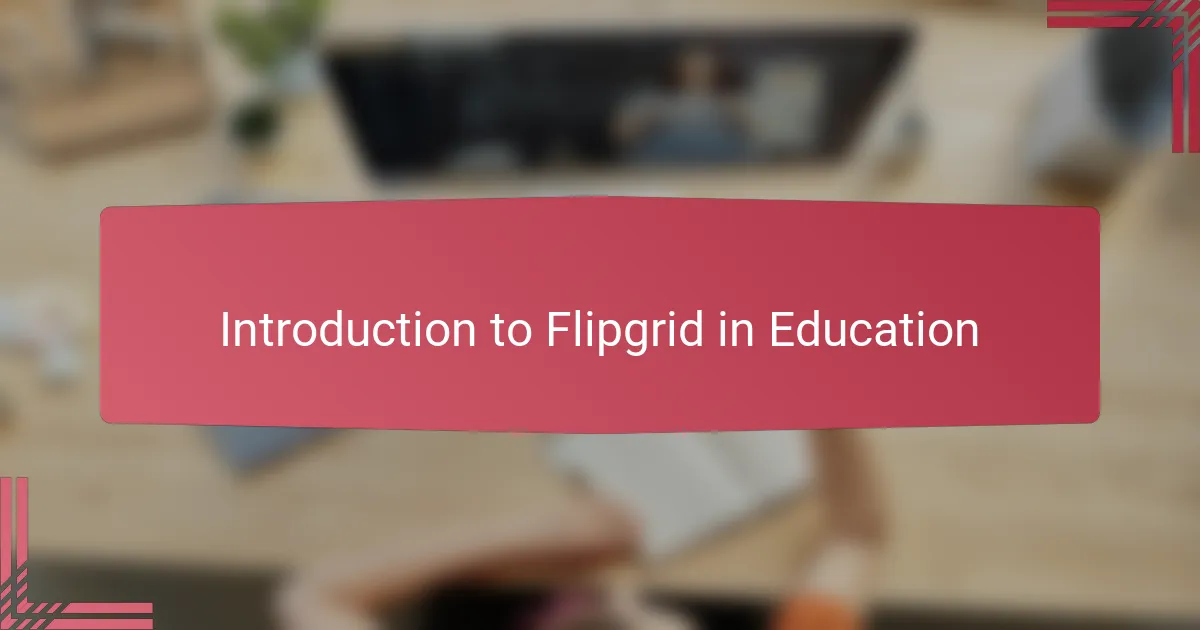
Introduction to Flipgrid in Education
Flipgrid is a simple yet powerful platform that invites students to share their thoughts through short videos. When I first introduced Flipgrid, I was surprised by how quickly it broke down barriers—shy students suddenly found their voices, and lively discussions emerged from the most unexpected places. Have you ever seen a tool change the classroom dynamic so effortlessly?
What I appreciate most about Flipgrid is its ability to make student responses feel personal and authentic. Instead of just writing down answers, students express emotions, ideas, and opinions in a way that feels alive. This transforms traditional participation into something more meaningful and connected.
Using Flipgrid also means creating a community where every voice matters. I’ve witnessed how even reluctant learners become engaged simply because they know their peers are listening. Isn’t that the kind of inclusive atmosphere every educator hopes to build?
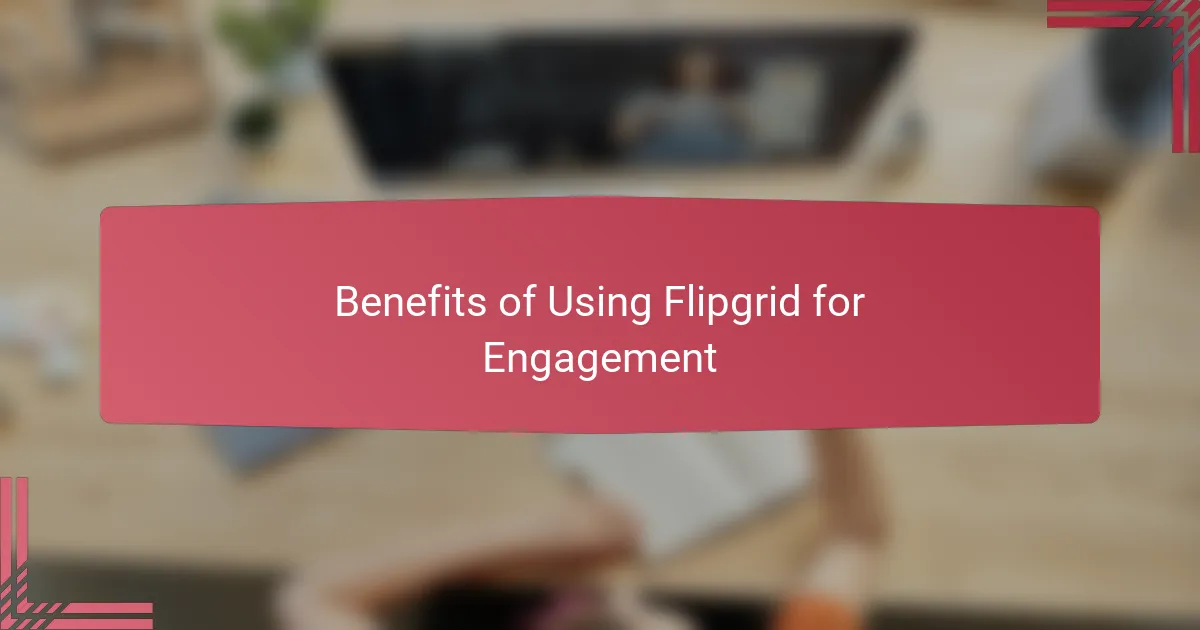
Benefits of Using Flipgrid for Engagement
One of the biggest benefits I’ve seen using Flipgrid is how it encourages all students to participate, not just the outgoing ones. There’s something about recording a video response that feels less intimidating than speaking up in front of the whole class. Have you noticed how students who are usually quiet suddenly become eager to share their thoughts when given this platform?
Another advantage is the way Flipgrid fosters deeper connections among students. When they hear their classmates’ voices and see their expressions, discussions move beyond surface-level answers. It’s like a window into their perspectives, making debates more empathetic and genuine in a way I hadn’t expected before.
I’ve also found that Flipgrid helps sustain engagement because students feel their ideas really matter—they’re not just giving answers for a grade but expressing themselves to a supportive audience. This sense of ownership shifts how they approach assignments and motivates them to dive in with more enthusiasm. Isn’t that the kind of engagement every teacher dreams of?
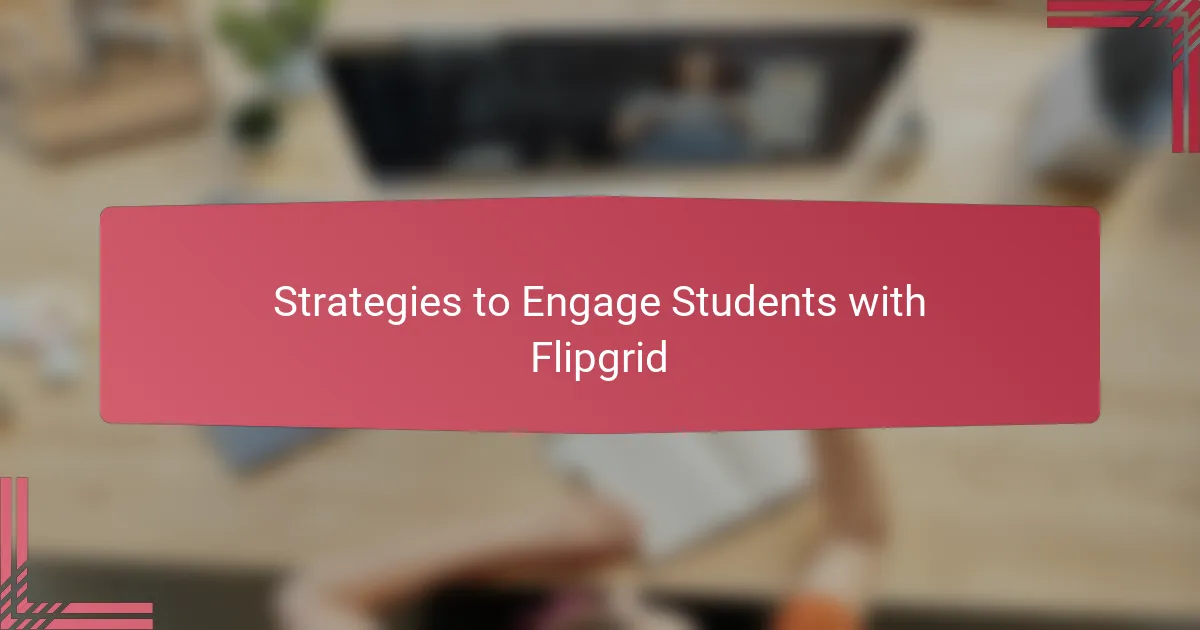
Strategies to Engage Students with Flipgrid
One strategy I’ve found effective is setting clear, open-ended prompts that invite students to share their personal experiences or opinions. When I framed questions around issues that mattered to them, their responses became more heartfelt and thoughtful. Have you ever noticed how a well-crafted question can completely change the energy of a discussion?
I also make it a point to model vulnerability through my own Flipgrid videos. By sharing my own reflections and struggles, I create a space where students feel safe to be authentic. This small act of openness often inspires them to dig deeper and express themselves more fully.
Finally, I encourage peer interaction by asking students to respond to each other’s videos thoughtfully. This not only builds a sense of community but also pushes them to consider diverse perspectives. Isn’t it amazing how hearing a classmate’s story can broaden one’s own understanding?
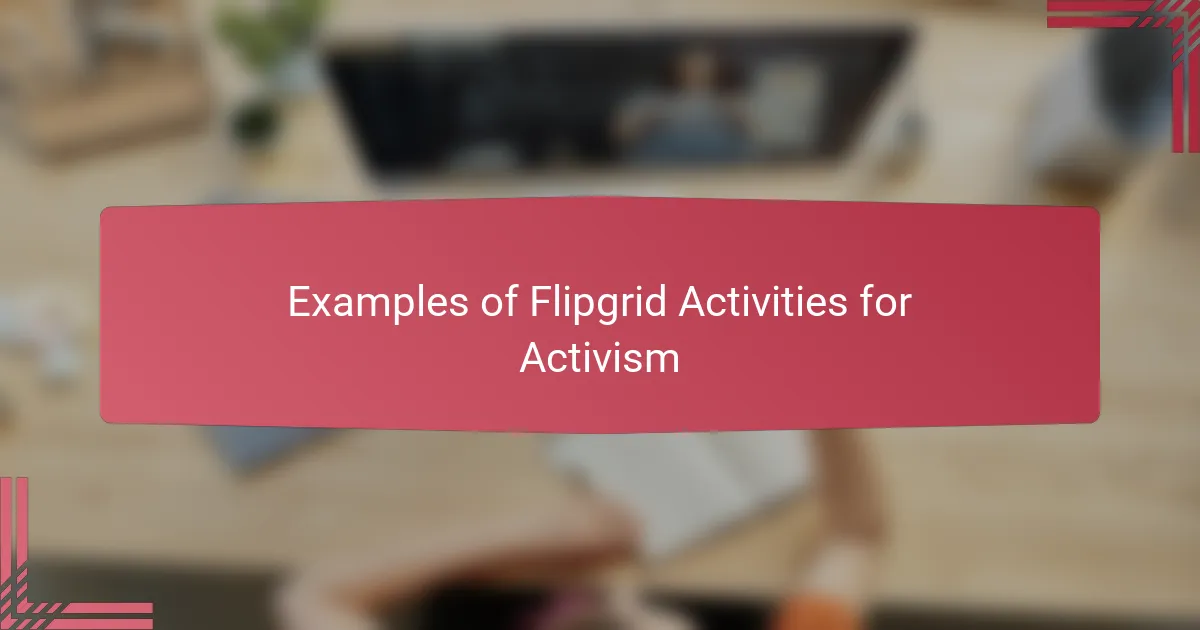
Examples of Flipgrid Activities for Activism
One memorable Flipgrid activity I created invited students to share stories of activists who inspired them personally. I was moved to see students connect deeply with these figures, explaining how their courage sparked hope or change in their own lives. Have you ever watched a shy student’s face light up as they discover their own power to influence the world through stories like these?
Another exercise encouraged students to film short calls-to-action on issues they cared about, from environmental justice to anti-bullying campaigns. The enthusiasm was palpable, and I noticed how making these videos gave their voices weight beyond the classroom walls. It made me think—how often do we provide real platforms for youth to speak out, not just talk about speaking out?
I also experimented with a Flipgrid debate where students responded to prompts about current social movements. Hearing their passionate, respectful disagreements revealed how Flipgrid can nurture critical thinking and empathy simultaneously. When I saw peers thoughtfully challenge each other’s perspectives, I realized this was activism in action—right there in our virtual circle.
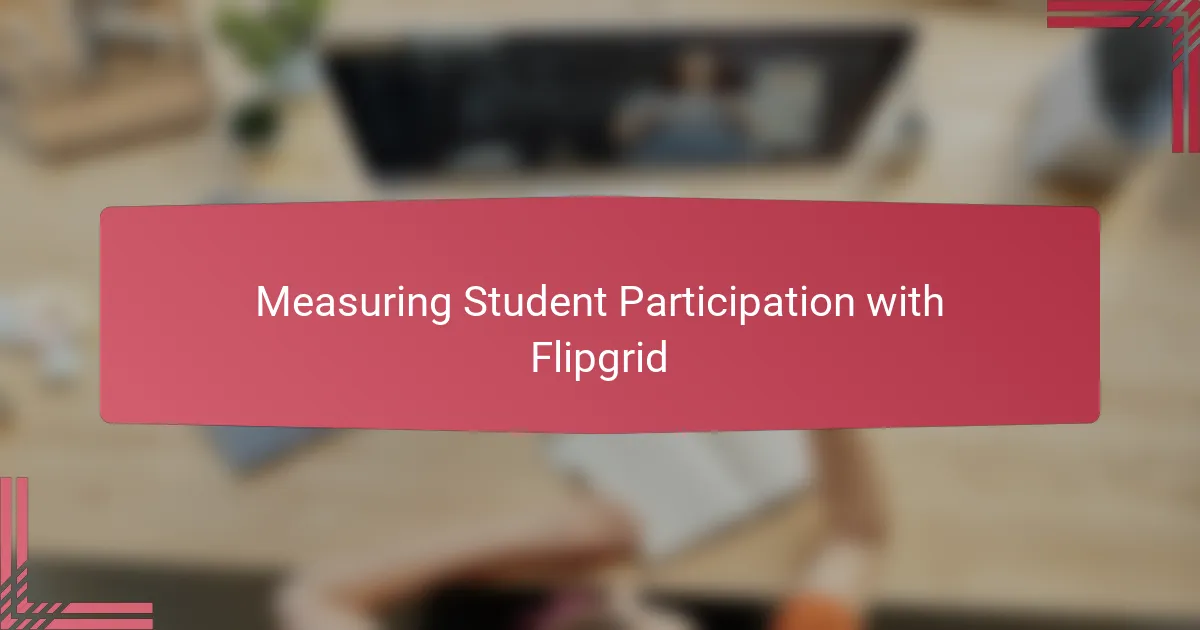
Measuring Student Participation with Flipgrid
Measuring student participation with Flipgrid is surprisingly straightforward, yet profoundly insightful. I often look beyond just the number of videos submitted and focus on the depth and variety of responses students share. Have you ever noticed how some students’ engagement shines through when they not only respond to prompts but also comment thoughtfully on their classmates’ videos? This interaction reveals true participation rather than mere compliance.
What really struck me is Flipgrid’s built-in analytics that offer an easy snapshot of student involvement. It tracks who’s posted, who’s watched, and who’s commented—giving me a clear picture of each student’s active presence. But for me, these numbers only tell part of the story; it’s the rich, personal reflections in their videos that show authentic engagement.
Sometimes, I sit back and watch the progression of responses over time. Seeing a quiet student gradually contribute more confidently or a peer respond with greater empathy makes me realize participation isn’t just about quantity—it’s about growth. Doesn’t that make measuring involvement feel more meaningful than a simple checklist?
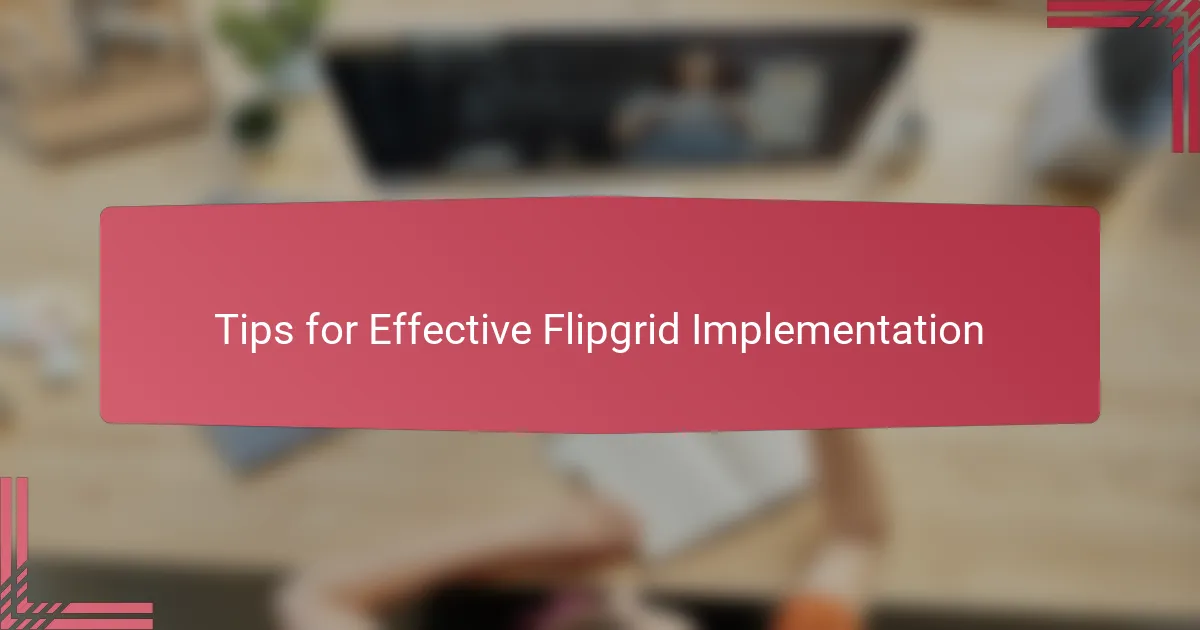
Tips for Effective Flipgrid Implementation
One tip I always emphasize is to keep the prompts clear and meaningful. When students understand exactly what’s expected but still have room to express their own ideas, their videos become authentic and engaged. Have you noticed how a simple, well-phrased question invites deeper reflection rather than surface answers?
I’ve also found it crucial to create a safe and supportive environment where students feel comfortable sharing. Early on, I shared my own video responses openly, which helped break the ice and set the tone. This little gesture often encouraged even the most hesitant students to take the plunge and reveal their true thoughts.
Another practical piece of advice is to build in time for students to interact with one another’s videos. The magic happens when they listen, reflect, and respond thoughtfully—turning a one-way assignment into a dynamic conversation. Isn’t it incredible how peer feedback can spark new insights and build a stronger sense of community?